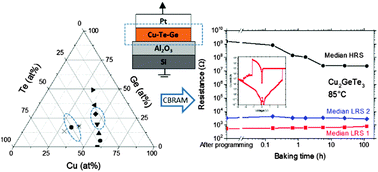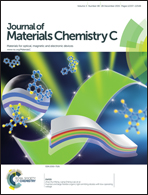Improved thermal stability and retention properties of Cu–Te based CBRAM by Ge alloying†
Abstract
In this work we investigate the influence of Ge as an alloying element in Cu–Te based thin films for application as a cation supply layer in Conductive Bridge Random Access Memory (CBRAM). The thermal stability of the alloys and their functionality as a copper supply layer in CBRAM are investigated. The thermal stability is studied by means of in situ X-ray diffraction, which reveals information on phase separation, phase transformations and melting of the material. We demonstrate that addition of Ge to Cu0.6Te0.4 inhibits crystallization up to 300 °C. However, phase separation occurs upon crystallization, which might result in device to device variability when this occurs in memory devices. This is solved by using Cu2GeTe3 that forms a single phase upon crystallization. The most promising alloys are implemented in 580 μm diameter dot Pt/CuxTeyGe1−x−y/Al2O3/Si CBRAM cells. Their functionality is verified by DC cycling and the influence of Ge is studied by comparing the switching to binary Cu0.6Te0.4 based memory cells. The retention of the programmed memory states is measured at 85 °C. Functional CBRAM is demonstrated, and improved filament stability and retention properties are observed for the Ge containing cells compared to Cu0.6Te0.4. We mainly attribute this to the Ge–Te bonds that are formed in the supply layer. This lowers the tendency for Cu–Te formation which results in a lower driving force for the Cu to go back to the supply layer, and hence contributing to a more stable filament. The formation of Ge–Te bonds was confirmed by XPS measurements.

- This article is part of the themed collection: 2015 Journal of Materials Chemistry C Hot Papers

 Please wait while we load your content...
Please wait while we load your content...